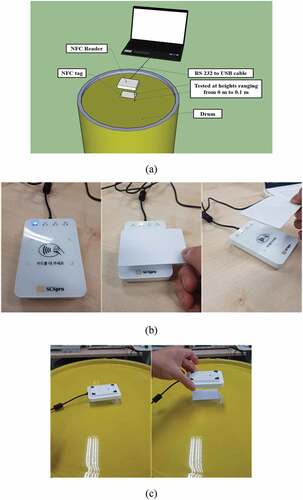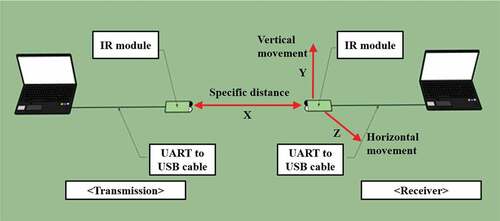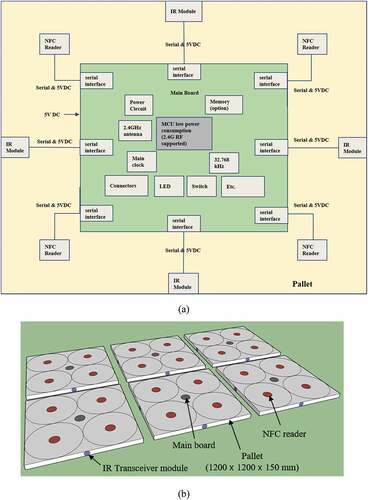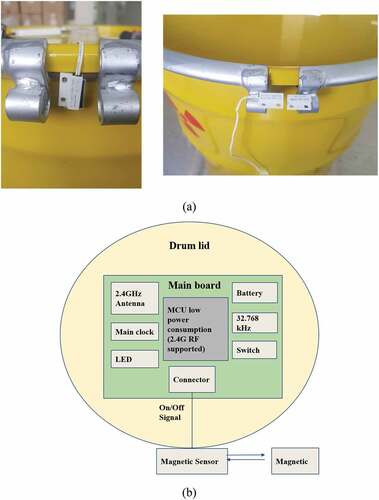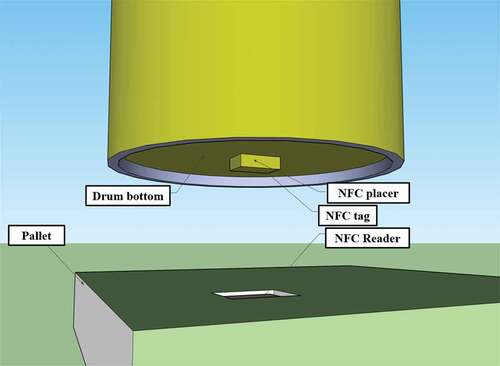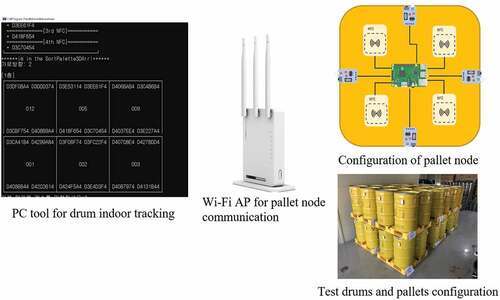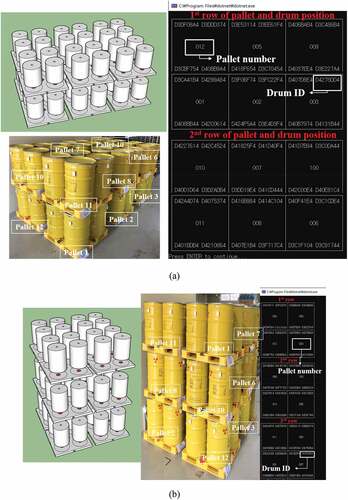ABSTRACT
Regulatory agencies and civil society organizations concerned with radioactive waste management are demanding maximized safety management of radioactive-waste-containing drums using advanced technology for more efficient and safe management. In the present paper, we propose a sensor system that can track and monitor drums containing low- and intermediate-level radioactive waste using advanced technology based on the Internet of Things (IoT). The proposed system consists of drum nodes, pallet nodes, and gateways. A drum node and magnetic sensor installed on a drum can be used to remotely check whether the drum lid is open or closed, and the location of the drum can be tracked using a near-field communication reader and an infrared module installed on the pallet node. Considering that radioactive waste is stored for a long time period, the proposed sensors are designed for low power consumption. Moreover, a pilot test involving 48 drums and 12 pallets was conducted to verify the system prototype. Accordingly, from the results of the pilot test, drawbacks were noted and solutions were proposed to improve the system in future work. Implications: We designed a test bed by fabricating a sensor-system prototype and used it in a simulation experiment. The results of this study will be used as basic data for establishing safety measures for radioactive waste management in the future through computer simulation of radioactive waste anomalies in a digital-twin system.
Introduction
As public concern about the effects of radioactive waste on health and the environment increases, it is emerging as a social problem (Ramana Citation2018). Accordingly, regulatory agencies and organizations are increasingly demanding new radioactive waste safety management systems. shows an entire cycle of the process from the generation of low- and intermediate-level radioactive waste to its transfer to a disposal site. A method to ensure that new technology can safely manage such waste during all the required procedures is urgently needed (Lee, Lee, and Lee Citation2013; Ojovan, Robbins, and Garamszeghy Citation2018; Tsoulfanids and Cochran Citation1991). Accordingly, the Korea Atomic Energy Research Institute (KAERI, South Korea) has been undertaking the task of establishing a radioactive waste safety management platform using various information and communication technologies (ICT), including the Internet of Things (IoT), big data, augmented reality, and digital-twin virtual representation. Throughout the entire radioactive waste processing cycle, countries that conduct nuclear operations and operate decommissioning facilities are building their own management systems and attempting to develop various technologies for the safe management of radioactive waste (Chae et al. Citation2020; Sakai et al. Citation2021; Wattal Citation2013; Wegel et al. Citation2019). The IoT is attracting attention as a core technology that could lead to the Fourth Industrial Revolution, and it has already been applied in various ways to life and industry (Al-Qurabat, Abdulzahra, and Idrees Citation2022; Al-Qurabat, Mohammed, and Hussein Citation2021; Liao et al. Citation2017; Pilloni Citation2018). Although various IoT-based technologies have been reported, the literature contains no accounts of their use in systems for safely managing radioactive waste (Pardini et al. Citation2019). An IoT-based technology for managing drums containing radioactive waste could be used to provide alarms to prevent theft or loss if a drum is moved from a storage facility. It could also provide notification if a truck is diverted from its planned route when transporting waste to a disposal site. This technology would have the advantage of being able to check the carry-in/carry-out information, loading location, and movement path using real-time monitoring of a drum of radioactive waste. Therefore, to provide safe and reliable storage and management of drums of radioactive waste, we herein propose an IoT-based system of indoor tracking sensors and condition-monitoring sensors for drums of radioactive waste ().
Figure 1. (a) Process for handling low- and intermediate-level radioactive waste from the generating facility to the disposal site. (b) a schematic of the proposed radioactive waste tracking system.
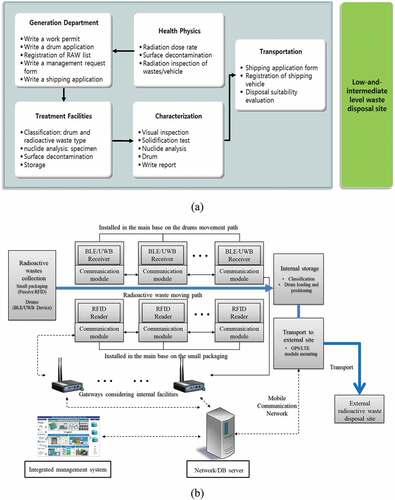
In this study, a reliable and safe management method of radioactive waste drums was proposed by applying an IoT-based system. Firstly, we report the status of the regulatory requirements of domestic and foreign countries regarding the application of IoT technology to the field of radioactive waste management. In addition, an IoT-based indoor tracking sensor for drums and a condition-monitoring sensor with a lid-on/lid-off function are described. We designed a test bed by fabricating a sensor-system prototype and used it in a simulation experiment. In the field management of drums of radioactive waste, the drums are stacked and packed in rows of four to five. The drums are made of metal, which can interfere with sensor communications. Therefore, a pallet-based location-tracking technology for drum storage and movement was applied in the present study. Because of the nature of radioactive waste, long-term storage and management are critical. Therefore, our design considered calculations of the expected power consumption of the sensors and appropriate measures were performed to improve their low-power operation. Finally, the feasibility of indoor location tracking and condition monitoring (i.e., a lid-on/lid-off function) was studied. The results from the pilot test were used to reveal drawbacks, and solutions to the drawbacks were proposed to improve the system in future work.
Investigation of regulations on IoT application to radioactive waste management
We analyzed the regulatory requirements that should be considered when applying IoT technology to radioactive waste management being implemented in Korea, where radioactive waste management is regulated by the Radioactive Waste Management Act and must meet relevant conditions of the radioactive waste management enforcement order, rules, and notifications under Article 2, paragraphs 2 and 3. In addition, according to the provisions of Article 13, radioactive waste management involving IoT devices must be observed at designated locations and management facilities. Technical standards for battery safety of IoT-related devices have not yet been included in the regulatory requirements. Therefore, the development of the necessary procedures and regulations would be worthwhile if the technology is commercialized. In the United States, regulations are applied according to the Nuclear Regulatory Commission (NRC) and Department of Energy (DOE) regulations based on the classification of radioactive waste. In the United States, there is currently no direct regulation on the use of IoT devices in relation to radioactive waste management. However, as the proportion of IoT devices has increased, agencies in the United States have recently begun focusing on security checks. Regulatory requirements for IoT devices are being investigated and formulated, and some are currently pending before the Federal Assembly (USA). The international standard (Y.2060) established in 2012 for the IoT has come to the forefront in the efforts of the International Telecommunication Union (ITU) to promote standardization. However, no IoT-related international standards or regulations for radioactive waste have yet been implemented.
Experimental setup
Test preparation of an NFC reader and tag and their corresponding transmit and receive performance
To reduce the interference of the metal drums with communications and to enable accurate recognition of the positions of drums, we used a pallet-based drum-tracking technology. A near-field communication (NFC) reader (and NFC tags) was used to recognize the position of a drum loaded onto a pallet. shows the NFC reader (RS232 type, 5 V input power), NFC tag (credit-card type), drum, laptop, RS232-to-USB cable, and NFC reader software (installed on the laptop) prepared for use in the performance test. To analyze the influence of the receiving distance based on the materials involved, a comparative analysis was conducted on a wooden table and metal drum (used for radioactive waste storage), as shown in b and c. Ash shown in , we placed an NFC reader on a wooden table and measured the recognition distance while changing the tag distance. In , the NFC tag was attached to the center of the bottom of the drum and the NFC reader was positioned above the NFC tag. The NFC reader was connected to a laptop that measured the recognition distance while the horizontal and vertical distances between the tag and the drum were varied.
Test preparation for IR technology performance
Petrellis, Konofaos, and Alexiou (Citation2006) reported that infrared-emitting diodes and sensors were applied for the architecture of an indoor target localization system. In this study, an infrared (IR) transmitter/receiver module was used to recognize a location among pallets while the pallets were loaded in bulk. We actually attached an IR device to a pallet used to stack radioactive waste drums, and performed IR transmit/receive tests using this IR-attached pallet within a radioactive waste storage area. Moreover, an IR transmitter/receiver module, serial interface (UART)-to-USB cable, and laptop were prepared for performance testing. The IR transceiver modules were positioned at the same height, and a laptop was connected to each module. As shown in , one module was designated as the transmitter and the other was designated as the receiver. The transmitter continuously sent the same signal so that the receiver could check the signal received on the laptop. The transmission and reception-recognition distance was measured while the height, horizontal angle, and distance from the module to the laptop were varied.
Configuration of a pallet
The pallet used to determine the actual tracking position was composed of a main board, NFC reader, and an IR transceiver module. For the pilot test, a total of 12 pallets were positioned in an array; the drum-position tracking experiment was then performed. shows the configuration diagram of the pallet, and shows the position of the module on the pallet. clarifies details specific to the components of the pallet. For actual commercialization, to design the circuit of a main board, components should be selected on the basis of low power usage. The pallet should be designed to enable wireless communication between the main boards. In addition, noise countermeasures and performance should be considered in the board design and component selection. The selected design shape should ensure that all components can be built on or incorporated into the pallet.
Table 1. Models and manufacturers of the modules used on a pallet.
Configuration of drum-lid-condition monitoring sensor
Monitoring the opening status of individual waste drums is an important factor in tracking the management history of waste drums. Accelerometers, gyro sensors, Hall sensors, illumination sensors, and magnetic sensors can be used as sensors to detect the open and closed states of a drum lid. Among these options, we determined that accelerometers and magnetic sensors are most appropriate for a drum of radioactive waste when feasibility and current consumption are considered. By examining the current consumption and the accuracy of the acceleration sensor, we determined that an acceleration sensor has difficulty recognizing an open drum lid when the opening angle is small. In the present study, we decided to use magnetic sensors and applied them in the pilot study because of their high feasibility of implementation and their advantage of minimal current consumption. Notably, the design of the module and lid monitoring function (distance between the sensors) can be changed depending on the method of engaging the drum lid and fastening part. The position and fastening type of the magnetic sensor are shown in shows the configuration of the drum-lid detection sensor. The analysis results are described in Section 4.
Results and discussion
Results of the NFC reader and tag transmit-and-receive test
Tests of the NFC reader and tag transmission and reception were performed as described in Section 3.1; the test results are summarized in . A signal was detected as far as 65 mm vertically from a general table (normal use environment). As a result of the transmission and reception tests from the drum surface, we determined that antenna communication was poor because of the influence of the metal floor. Moreover, the sending and receiving distance gradually increased with increasing distance of the tag from the metal drum. We also confirmed that the transmission and reception efficiency decreased when the tag and the reader were not centrally located. Therefore, we determined through experiments that the NFC tag should be placed on the bottom of a drum and that the drum should be placed as close as possible to the reader. As shown in , the NFC transceiver module was spaced apart (separated) from the bottom of the metal drum using a nonmetal material approximately 15 mm thick and the NFC tag was placed at the center of the bottom of the drum. As also shown in , an NFC reader was incorporated by creating a space in the center of the pallet on which the drum was located.
Table 2. Operational vertical distance range according to the distance between NFC tag and drum surface.
Test results of IR function performance
IR performance tests were conducted as indicated in Section 3.2. To recognize the proper position among the pallets, vertical and horizontal positions were changed and the recognition angle and distance were measured; the results are shown in . The test preparation, including the recognition distance and angle, is shown in .
Table 3. Results of the IR transmit/receive test.
The recognition angle was 126.8°, 112.6°, 62.0°, and 51.2° when the distance between the transmitter and receiver was 10, 20, 100, and 250 cm, respectively. The horizontal angle was 119°, 107°, and 48.4° when the distance between transmitter and receiver was 10, 20, and 100 cm, respectively. As a result, we confirmed that the difference between the horizontal and vertical recognition rates was not large. Moreover, we confirmed that the recognition angle was wide when the transmission/reception distance was short and that the angle was narrow when the transmission/reception distance was long. We determined by analysis that, at a short distance, the signal intensity was strong; therefore, the recognition angle was large. With increasing distance, the signal intensity was radially weakened.
We used various materials between the transmitting and receiving modules to determine whether they would block the electromagnetic waves. The results in indicate that electromagnetic wave-blocking occurred with most materials (except thin paper). From the measurement results for the IR transmission and reception recognition distance and angle, we expected that the position of the pallet could be recognized over a sufficiently wide range. Therefore, we also judged that the NFC tags exhibited no problem with transmission and reception performance when installed in the center of the four sides of pallets. The results confirmed that the transmission and reception angle can be easily changed using substances with various signal-blocking functions (shown in ) when there is an environment in which reception must be restricted for security or other specific reasons.
Table 4. Test results according to the materials interfering with electromagnetic signals between the transmitting and receiving modules.
Function analysis for monitoring of drum lid-open and lid-closed conditions
As shown in a and b, a magnetic sensor was attached to the fastening part of the drum lid for the safety management of drums of radioactive waste. This configuration enables lid-open and lid-closed conditions to be detected and analyzed. shows the sensor-function analysis results according to the magnetic-sensor position. In the left side of , the magnet is placed on the top of the drum body and the sensor is placed above the lid of the drum. If the distance between the sensor and magnet is greater than 4 mm, lid opening and closing can be detected; thus, whether a drum lid is open can certainly be monitored. However, we determined that this sensor structure could cause interference or discomfort to an operator managing the drum. The right side of shows a configuration in which the magnet is positioned between the fastening parts and in which the sensor and the magnet are positioned horizontally between the fastening parts of the drum lid. The lid-open or lid-closed status can be detected when the distance between the sensor and the magnet is 3 mm or greater; thus, the drum lid-open state can be monitored reliably in real time. In addition, because it is installed in the same position as the bolting device used to fasten the lid, there is a positional advantage in that it does not interfere with the activities of a drum manager.
Table 5. Results from analysis of the sensor characteristics according to the position of the magnetic sensor.
Analysis of the power consumption characteristics of each positioning module
Because of the nature of radioactive waste, its long-term storage and management are critical. Accordingly, the use of a module that exhibits low power consumption is required. In this section, we derived the current consumption expected for drums and pallets by checking the current consumption of each module and other components. First, the magnetic sensor used for lid-state monitoring (attached to the drum) was in an open state when an event occurred; at this time, no current was consumed. In the closed state, a current consumption of 360 µA was expected under the condition of 3.6 V/10 kΩ and the current consumption could be reduced by an increase in the resistance. The module attached to the drum-storage pallet has an IR sensor and an NFC reader. The IR sensor used in the present work has a built-in chip that operates at 5 Vdc to convert IR data into UART. When operating only for reception, a current of 16.4 mA is consumed, on average. We confirmed that the NFC reader consumes an average current of 190 mA (minimum 48 mA, maximum 282 mA) for 3 min when waiting and an average current of 203 mA (minimum 48 mA, maximum 282 mA) for 3 min when receiving signals from a tag. summarizes the expected power consumption and life expectancy of a module attached to the drum. We concluded that a life expectancy of approximately 1667 or 1000 days can be expected, depending on the presence or absence of a router function, if three 2400 mAh batteries with a voltage of 3.6 V are used. summarizes the expected power consumption and life of a module attached to the pallet. We determined that, when a battery with an average capacity of 20,000 mAh is used, a module can be used for approximately 456 days, depending on the aforementioned conditions. If the storage days are longer, it will be necessary to configure the module system in such a way as to increase the battery capacity and use low-power components.
Table 6. Estimated power consumption of a drum node.
Table 7. Estimated power consumption of a pallet node.
Results of the pilot test
Detection test of the drum lid-open and lid-closed function
For the minimum practical pilot test, 48 drums and 12 pallets were prepared and the drum-position and lid-condition monitoring tests were conducted in relation to changes in their arrangement. To check if the drum lid was open or closed, a magnetic sensor was installed in the part that engaged the lid. In addition, after checking the open/closed status visually and remotely, we confirmed the result using a temporarily produced web client. As shown in , we confirmed the status of the lid as open or closed using the lid detection sensor and the web client. We also tested the monitoring of numerous drum-lid states and confirmed that the web client status changed () when the lids on drums 42, 44, and 45 were opened.
Drum-tracking test using pallet node
Pallets were placed in a 2 × 3 × 2 array and in a 2 × 2 × 3 array for the drum-tracking test, and the two arrays were tested sequentially. We developed a PC tool for temporary use only to identify visually the drum number and position for the pilot test. Moreover, the NFC readers and tags were installed on each pallet and drum, respectively. As shown in , the test setup consisted of a PC tool for positioning the drum, a pallet node, drums and pallets, and a Wi-Fi application for communication with the pallet node. shows the pallet configuration of the 2 × 3 × 2 array; we confirmed that the location was accurately displayed on the PC tool according to the serial numbers of the pallet and drum. shows the pallet configuration of the 2 × 2 × 3 arrangement; we confirmed that the serial numbers of the pallets and drums were correctly displayed on the PC tool.
Future works
Pallet configurations
In the present study, a module was mounted onto a pallet by being attached to the top or side of the pallet. However, for durability and protection of the devices, it is necessary to develop a new pallet that incorporates all the components. Preferably, a module assembly would be developed in a form that would allow both its attachment to an detachment from an existing pallet.
Performance of the IR sensors
An IR sensor condition might be too different from the optimal transmitting/receiving distance, or the positioning performance between short pallets might deteriorate; therefore, such drawbacks needs to be properly addressed to accommodate environmental conditions. Sensor stands or similar devices that prevent the isotropically radiated IR sensor signals from being transmitted to unnecessary positions need to be designed.
Performance of the NFCs
Although the existing NFC reader has sufficient vertical recognition performance, recognizing a drum based on the horizontal recognition performance might be difficult. Therefore, the antenna-enhanced performance of a commercial NFC reader is needed to complement the current horizontal performance.
Effects of external noise and radioactivity
The modules should be designed and manufactured with adequate shielding from external noise given their operation in various environments. Moreover, the modules must also minimize the effect of radiation on the device and its operation.
Circuit simplification and shock preparedness
The circuit should be simplified to minimize the causes of failure or defects. Moreover, internal assembly is required to achieve sufficient impact resistance given the potential for substantial impacts during pallet handling.
Conclusion
For the safety management of drums containing radioactive waste, a sensor system was designed to enable indoor position tracking by monitoring the status of radioactive waste drums and their pallets. Tests were conducted on the basis of a number of considered conditions. Pallet-based positioning technology was used because of interference with the signals by the metal drum material and because of the characteristics imposed by storage density. Using IR and NFC modules, we confirmed that the positions of drums and pallets could be accurately displayed in the PC tool according to the serial number of each pallet and drum. Because of its low power consumption and ease of processing, a magnetic sensor was used to monitor the state of the drum lids. The status was well displayed in the web client when a drum lid was opened more than 3 mm.
During the course of this research, we built and verified a prototype system that can manage drums of radioactive waste based on an IoT module. We also identified a number of inadequacies that require improvement. In the future, we will not only further develop the indoor position tracking applied in the present work, but will also develop technology that can track and monitor movement outside of a drum in real time. We also plan to design an inside/outside monitoring device for a more advanced IoT-based radioactive-waste-drum management system and develop a condition-monitoring sensor that can provide various drum information (e.g., radioactivity, temperature, humidity, and impacts). Finally, we aim to optimize all the necessary modules. The results of this study will be used as basic data for establishing safety measures for radioactive waste management in the future through computer simulation of radioactive waste anomalies in a digital-twin system.
Disclosure statement
No potential conflict of interest was reported by the author(s).
Additional information
Funding
References
- Al-Qurabat, A. K. M., S. A. Abdulzahra, and A. K. Idrees. 2022. Two-level energy-efficient data reduction strategies based on SAX-LZW and hierarchical clustering for minimizing the huge data conveyed on the internet of things networks. J. Supercomput. 78 (16):1–47. In Press. doi:10.1007/s11227-022-04548-7.
- Al-Qurabat, A. K. M., Z. A. Mohammed, and Z. J. Hussein. 2021. Data traffic management based on compression and MDL techniques for smart agriculture IoT, Wirel. Pers. Commun. 120 (3):2227–58. doi:10.1007/s11277-021-08563-4.
- Chae, S., S. Park, S. Kim, J. Min, J. Lee, and J. Lee. 2020. An external dose assessment of worker during radwaste treatment facility decommissioning. J. Radiat. Prot. Res. 45 (2):81–87. doi:10.14407/jrpr.2020.45.2.81.
- Lee, Y. S., J. W. Lee, and Y. J. Lee. 2013. Development of the process mapping for the radiation safety management. J. Radiat. Prot. Res. 38 (3):149–56. doi:10.14407/jrp.2013.38.3.149.
- Liao, Y., E. R. Loures, F. Deschamps, G. Brezinski, and A. Venancio. 2017. The impact of the fourth industrial revolution: A cross-country/region comparison. Production. 28 (0):e20180061. doi:10.1590/0103-6513.20180061.
- Ojovan, M., R. Robbins, and M. Garamszeghy. 2018. Advances in conditioning of low- and intermediate- level nuclear waste. MRS. Adv. 3 (19):983–90. doi:10.1557/adv.2017.613.
- Pardini, K., J. Rodrigues, S. A. Kopzlov, N. Kumar, and V. Furtado. 2019. IoT-based solid waste management solutions: A survey. J. Sens. Actuator. Netw. 8 (1):5–29. doi:10.3390/jsan8010005.
- Petrellis, N., N. Konofaos, and G. P. Alexiou. 2006. Target localization utilizing the success rate in infrared pattern recognition. IEEE Sens. J. 6 (5):1355–64. doi:10.1109/JSEN.2006.881342.
- Pilloni, V. 2018. How data will transform industrial processes: Crowdsensing, crowdsourcing and big data as pillars of industry 4.0. Future. Internet. 10 (3):24. doi:10.3390/fi10030024.
- Ramana, M. V. 2018. Technical and social problems of nuclear waste. WIREs Energy. Environ. 7 (4):e289. doi:10.1002/wene.289.
- Sakai, K., Y. Yamada, K. Yoshida, S. Yoshinaga, K. Sato, H. Ogata, T. Iwasaki, S. Kudo, Y. Asada, I. Kawaguchi, et al. 2021. Conclusions and suggestions on low-dose and low-dose rate radiation risk estimation methodology. J. Radiat. Prot. Res. 46 (1):14–23. doi:10.14407/jrpr.2020.00262.
- Tsoulfanids, N., and R. G. Cochran. 1991. Radiowaste waste management. Nucl. Technol. 93 (3):263–304. doi:10.13182/NT91-A34525.
- Wattal, P. K. 2013. Indian programme on radioactive waste management. Sadhana. 38:849–57. doi:10.1007/s12046-013-0170-0.
- Wegel, S., V. Czempinski, P. Oei, and B. Wealer. 2019. Transporting and Storing High-Level Nuclear Waste in the U.S.—Insights from a Mathematical Model. Appl. Sci. 9 (12):2437. doi:10.3390/app9122437.

